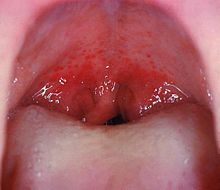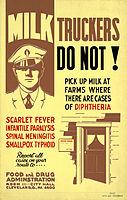Scarlet fever
| Scarlet fever | |
|---|---|
| Other names | Scarlatina, |
| Prognosis | Typically good[1] |
Scarlet fever, also known as scarlatina, is an
Scarlet fever develops in a small number of people who have
There is no
In the early 20th century it was a leading cause of death in children, but even before the
Signs and symptoms
Scarlet fever typically presents with a sudden onset of sore throat, fever, and malaise. Headache, nausea, vomiting and abdominal pain may also be present.[11] Scarlet fever usually follows from a group A streptococcal infection that involves a strep throat such as streptococcal tonsillitis or more usually streptococcal pharyngitis. Often these can present together known as pharyngotonsillitis. The signs and symptoms are therefore those of a strep throat but these are followed by the inclusion of the characteristic widespread rash.[12] The rash usually appears one to two days later but may appear before or up to seven days following feeling ill.[1]
It generally hurts to swallow.[1] However, not all cases present with a fever, the degree of tiredness may vary, the sore throat and tongue changes might be slight or absent, and the rash can be patchy rather than diffuse in some.[5][page needed] Cough, hoarseness, runny nose, diarrhea, and conjunctivitis are typically absent in scarlet fever; such symptoms indicate what is more likely a viral infection.[13]
Mouth and throat


Rash




The characteristic rash has been denoted as "scarlatiniform", and it appears as a diffuse redness of the skin with small bumps resembling goose bumps.
Variable presentations
Children younger than five years old may have atypical presentations. Children younger than 3 years old can present with nasal congestion and a lower grade fever.[22] Infants may present with symptoms of increased irritability and decreased appetite.[22]
Complications
The complications, which can arise from scarlet fever when left untreated or inadequately treated, can be divided into two categories: suppurative and nonsuppurative.[4]
In the second case, the streptococcal infection may spread through the lymphatic system or the blood to areas of the body further away from the pharynx. A few examples of the many complications that can arise from those methods of spread include endocarditis, pneumonia, or meningitis.[23]
Nonsuppurative complications: These complications arise from certain subtypes of group A streptococci that cause an autoimmune response in the body through what has been termed molecular mimicry. In these cases, the antibodies which the person's immune system developed to attack the group A streptococci are also able to attack the person's own tissues. The following complications result, depending on which tissues in the person's body are targeted by those antibodies.[17]
- Aboriginal and Torres Strait Islander communities.[10]
- Poststreptococcal glomerulonephritis: This is inflammation of the kidney, which presents 1–2 weeks after a group A streptococcal pharyngitis. It can also develop after an episode of Impetigo or any group A streptococcal infection in the skin (this differs from acute rheumatic fever which only follows group A streptococcal pharyngitis).[21][24] It is the result of the autoimmune response to the streptococcal infection affecting part of the kidney. Persons present with what is called acute nephritic syndrome, in which they have high blood pressure, swelling, and urinary abnormalities. Urinary abnormalities include blood and protein found in the urine, as well as less urine production overall.[21]
- Poststreptococcal reactive arthritis: The presentation of arthritis after a recent episode of group A streptococcal pharyngitis raises suspicion for acute rheumatic fever, since it is one of the Jones criteria for that separate complication. But, when the arthritis is an isolated symptom, it is referred to as poststreptococcal reactive arthritis. This arthritis can involve a variety of joints throughout the body, unlike the arthritis of acute rheumatic fever, which primarily affects larger joints such as the knee joints. It can present less than 10 days after the group A streptococcal pharyngitis.[21]
Cause
Strep throat spreads by close contact among people, via respiratory droplets (for example, saliva or nasal discharge).[21] A person in close contact with another person infected with group A streptococcal pharyngitis has a 35% chance of becoming infected.[22] One in ten children who are infected with group A streptococcal pharyngitis will develop scarlet fever.[16]
Pathophysiology

The rash of scarlet fever, which is what differentiates this disease from an isolated group A strep pharyngitis (or strep throat), is caused by specific strains of group A streptococcus that produce a streptococcal pyrogenic exotoxin,[21] which is mainly responsible for the skin manifestation of the infection.[25] These toxin-producing strains cause scarlet fever in people who do not already have antitoxin antibodies. Streptococcal pyrogenic exotoxins – SPEs A, B, C. and F have been identified. The pyrogenic exotoxins, also called erythrogenic toxins, cause the erythematous rash of scarlet fever.[26][21] The strains of group A streptococcus that cause scarlet fever need specific bacteriophages for there to be pyrogenic exotoxin production. Specifically, bacteriophage T12 is responsible for the production of speA.[27] Streptococcal Pyrogenic Exotoxin A, speA, is the one most commonly associated with cases of scarlet fever that are complicated by the immune-mediated sequelae of acute rheumatic fever and post-streptococcal glomerulonephritis.[15]
These toxins are also known as "superantigens" because they can cause an extensive immune response by activating some of the cells that are mainly responsible for the person's immune system.[20] Although the body responds to the toxins it encounters by making antibodies, those antibodies will only protect against that particular subset of toxins. They will not necessarily completely protect a person from future group A streptococcal infections, because there are 12 different pyrogenic exotoxins that may be produced by the disease, and future infections may produce a different subset of those toxins.[21]
Microbiology
The disease is caused by secretion of
The T12 virus itself has not been placed into a taxon by the International Committee on Taxonomy of Viruses. It has a double-stranded DNA genome and on morphological grounds appears to be a member of the Siphoviridae.[31]
The speA gene was cloned and sequenced in 1986.
Streptococcal phages other than T12 may also carry the speA gene.[33]
Diagnosis
Although the presentation of scarlet fever can be clinically diagnosed, further testing may be required to distinguish it from other illnesses.
The rapid antigen detection test is a very specific test but not very sensitive. This means that if the result is positive (indicating that the group A strep antigen was detected and therefore confirming that the person has a group A strep pharyngitis), then it is appropriate to treat the people with scarlet fever with antibiotics. But, if the rapid antigen detection test is negative (indicating that they do not have group A strep pharyngitis), then a throat culture is required to confirm, as the first test could have yielded a false negative result.[34] In the early 21st century, the throat culture is the current "gold standard" for diagnosis.[22]
Serologic testing seeks evidence of the antibodies that the body produces against the streptococcal infection, including antistreptolysin-O and antideoxyribonuclease B. It takes the body 2–3 weeks to make these antibodies, so this type of testing is not useful for diagnosing a current infection. But it is useful when assessing a person who may have one of the complications from a previous streptococcal infection.[16][22]
Throat cultures done after antibiotic therapy can show if the infection has been removed. These throat swabs, however, are not indicated, because up to 25% of properly treated individuals can continue to carry the streptococcal infection while being asymptomatic.[24]
Differential diagnosis
Scarlet fever might appear similar to
- Viral exanthem: Viral infections are often accompanied by a rash which can be described as morbilliform or maculopapular. This type of rash is accompanied by a prodromal period of cough and runny nose in addition to a fever, indicative of a viral process.[17]
- Allergic or contact dermatitis: The erythematous appearance of the skin will be in a more localized distribution rather than the diffuse and generalized rash seen in scarlet fever.[16]
- Drug eruption: These are potential side effects of taking certain drugs such as penicillin. The reddened maculopapular rash which results can be itchy and be accompanied by a fever.[35]
- Kawasaki disease: Children with this disease also present with a strawberry tongue and undergo a desquamative process on their palms and soles. However, these children tend to be younger than five years old, their fever lasts longer (at least five days), and they have additional clinical criteria (including signs such as conjunctival redness and cracked lips), which can help distinguish this from scarlet fever.[36]
- Toxic shock syndrome: Both streptococcal and staphylococcal bacteria can cause this syndrome. Clinical manifestations include diffuse rash and desquamation of the palms and soles. It can be distinguished from scarlet fever by low blood pressure, lack of sandpaper texture for the rash, and multi-organ system involvement.[37]
- Staphylococcal scalded skin syndrome: This is a disease that occurs primarily in young children due to a toxin-producing strain of the bacteria Staphylococcus aureus. The abrupt start of the fever and diffused sunburned appearance of the rash can resemble scarlet fever. However, this rash is associated with tenderness and large blister formation. These blisters easily pop, followed by causing the skin to peel.[38]
- Staphylococcal scarlet fever: The rash is identical to the streptococcal scarlet fever in distribution and texture, but the skin affected by the rash will be tender.[5]
Prevention
One method is long-term use of antibiotics to prevent future group A streptococcal infections. This method is only indicated for people who have had complications like recurrent attacks of acute rheumatic fever or rheumatic heart disease. Antibiotics are limited in their ability to prevent these infections since there are a variety of subtypes of group A streptococci that can cause the infection.[21]
Although there are currently no vaccines available, the vaccine approach has a greater likelihood of effectively preventing group A streptococcal infections in the future because vaccine formulations can target multiple subtypes of the bacteria.[21] A vaccine developed by George and Gladys Dick in 1924 was discontinued[when?] due to poor efficacy and the introduction of antibiotics. Difficulties in vaccine development include the considerable strain variety of group A streptococci present in the environment and the amount of time and number of people needed for appropriate trials for safety and efficacy of any potential vaccine.[39] There have been several attempts to create a vaccine in the past few decades. These vaccines, which are still in the development phase, expose the person to proteins present on the surface of the group A streptococci to activate an immune response that will prepare the person to fight and prevent future infections.[40]
There used to be a diphtheria scarlet fever vaccine.[41] It was, however, found not to be effective.[42] This product was discontinued by the end of World War II.[citation needed]
Treatment
The antibiotic of choice is
Antibiotic resistance and resurgence
A
There was also an outbreak in the UK in 2014, and the National Health Service reported a 68% increase in the number of S. pyogenes identified in laboratory reports between 2014 and 2018.[10]
New research published in October 2020 indicates that the bacterium appears to be getting more robust after being infected with viruses,[10] specifically the North-East Asian serotype M12 (emm12) (group A Streptococcus, GAS).[45] They found three new genes, acquired from viruses, which cause development of "superantigens" targeting white blood cells, resulting in a more virulent strain of the bacterium.[10]
A vaccine that will protect against the 180 to 200 types of bacteria causing the disease has been worked on for over 20 years, but as of 2020[update] a safe one had not yet been developed.[10]
Epidemiology
Scarlet fever occurs equally in both males and females.[16] Children are most commonly infected, typically between 5–15 years old. Although streptococcal infections can happen at any time of year, infection rates peak in the winter and spring months, typically in colder climates.[21]
The morbidity and mortality of scarlet fever has declined since the 18th and 19th centuries when there were epidemics of this disease.[46] Around 1900 the mortality rate in multiple places reached 25%.[47] The improvement in prognosis can be attributed to the use of penicillin in the treatment of this disease.[13] The frequency of scarlet fever cases has also been declining over the past century.
There have been several reported outbreaks of the disease in various countries in the past decade.[48] The reason for these increases remains unclear in the medical community. Between 2013 and 2016 population rates of scarlet fever in England increased from 8.2 to 33.2 per 100,000 and hospital admissions for scarlet fever increased by 97%.[49] Further increases in the reporting of scarlet fever cases have been noted in England during the 2021–2022 season (September to September) and so far also in the season 2022–2023.[50] The World Health Organization has reported an increase in scarlet fever (and iGAS – invasive GAS cases) in England, and other European countries during this time. Increases have been reported in France and Ireland.[51] In the US, cases of scarlet fever are not reported, but as of December 2022, the CDC was looking at a possible increase in the numbers of invasive GAS infections reported in children.[52] In late December 2022, the CDC's Health Alert Network issued an advisory on the reported increases in invasive GAS infections.[53]
History
It is unclear when a description of this disease was first recorded.[54] Hippocrates, writing around 400 BC, described the condition of a person with a reddened skin and fever.[55]
The first unambiguous description of the disease in the medical literature appeared in the 1553 book De Tumoribus praeter Naturam by the
In 1675 the term that has been commonly used to refer to scarlet fever, "scarlatina", was written by Thomas Sydenham, an English physician.[55]

In 1827, Richard Bright was the first to recognize the involvement of the renal system in scarlet fever.[citation needed]
The association between streptococci and disease was first described in 1874 by Theodor Billroth, discussing people with skin infections.[55] Billroth also coined the genus name Streptococcus. In 1884 Friedrich Julius Rosenbach edited the name to its current one, Streptococcus pyogenes, after further looking at the bacteria in the skin lesions.[55] The organism was first cultured in 1883 by the German surgeon Friedrich Fehleisen from erysipelas lesions.[citation needed]
Also in 1884, the German physician Friedrich Loeffler was the first to show the presence of streptococci in the throats of people with scarlet fever. Because not all people with pharyngeal streptococci developed scarlet fever, these findings remained controversial for some time. The association between streptococci and scarlet fever was confirmed by Alphonse Dochez and George and Gladys Dick in the early 1900s.[56]
Also in 1884, the world's first convalescent home for people with scarlet fever was opened at Brockley Hill, Stanmore, founded by Mary Wardell.[57]
Nil Filatov (in 1895) and Clement Dukes (in 1894) described an exanthematous disease which they thought was a form of rubella, but in 1900, Dukes described it as a separate illness which came to be known as Dukes' disease,[58] Filatov's disease, or fourth disease. However, in 1979, Keith Powell identified it as in fact the same illness as the form of scarlet fever which is caused by staphylococcal exotoxin and is known as staphylococcal scalded skin syndrome.[59][60][61][62]
Scarlet fever serum from horses' blood was used in the treatment of children beginning in 1900 and reduced mortality rates significantly.[63]
In 1906, Austrian
There was a widespread epidemic of scarlet fever in 1922. Amongst the victims of this epidemic was Agathe Whitehead.
An antitoxin for scarlet fever was developed in 1924. The discovery of penicillin and its subsequent widespread use significantly reduced the mortality of this once-feared disease. The first toxin which causes this disease was cloned and sequenced in 1986 by Weeks and Ferretti.[32]
The incidence of scarlet fever was reported to be increasing in countries including England, Wales, South Korea, Vietnam, China, and Hong Kong in the 2010s; the cause had not been established as of 2018.
The Dick test
The Dick test, developed in 1924 by
-
Otto Kalischer wrote a doctoral thesis on scarlet fever in 1891.
-
A 1930s American poster attempting to curb the spread of such diseases as scarlet fever by regulating milk supply
-
Gladys Henry Dick (pictured) and George Frederick Dick developed an antitoxinand vaccine for scarlet fever in 1924 which were later eclipsed by penicillin in the 1940s.
References
- ^ a b c d e f g h i j k l m n o p q r s t u v w x y "Scarlet Fever: All You Need to Know". Center for Disease Control and Prevention. 31 October 2022. Archived from the original on 15 December 2022. Retrieved 17 December 2022.
- ISBN 978-0199206872.
- ^ a b "Scarlet Fever: Information For Clinicians | CDC". www.cdc.gov. 19 December 2022. Retrieved 22 December 2022.
- ^ PMID 29939666.
- ^ ISBN 978-0-323-77788-9.
- ISBN 978-0-323-71159-3.
- ^ "Scarlet fever: symptoms, diagnosis and treatment". GOV.UK. Retrieved 22 December 2022.
- ISBN 9780199572922. Archivedfrom the original on 14 February 2017.
- ISBN 978-0-19-871930-4.
- ^ a b c d e f Richardson, Holly (7 October 2020). "Scarlet fever is making a comeback after being infected with a toxic virus, researchers say". ABC News (Australian Broadcasting Corporation). Retrieved 27 November 2020.
- PMID 26866221. Retrieved 22 December 2022.
- ^ ISBN 978-0-323-54753-6.
- ^ PMID 26866221.
- ^ Ferri, Fred (2018). Ferri's Clinical Advisor 2018. Elsevier. p. 1143.
- ^ a b Goldsmith, Lowell; Katz, Stephen; Gilchrist, Barbara; Paller, Amy; Leffell, David; Wolff, Klaus (2012). Fitzpatrick's Dermatology in General Medicine. McGraw Hill.
- ^ a b c d e Usatine, Richard (2013). Color Atlas of Family Medicine, Second Edition. McGraw Hill Companies.
- ^ a b c Kaspar, Dennis; Fauci, Anthony; Hauser, Stephen; Longo, Dan; Jameson, J. Larry; Loscalzo, Joseph (2015). Harrison's Principles of Internal Medicine, 19th edition. McGraw Hill Education.
- ^ ISBN 978-0-323-55087-1.
- ISBN 978-0-7020-7963-4.
- ^ a b Marks, James; Miller, Jeffrey (2013). Lookingbill and Marks' Principles and Dermatology, Fifth Edition. Elsevier. pp. 183–195.
- ^ a b c d e f g h i j k l m n o Kliegman, Robert; Stanton, Bonita; St Geme, Joseph; Schor, Nina (2016). Nelson Textbook of Pediatrics. Elsevier. pp. 1327–1337.
- ^ S2CID 207170856.
- ^ Bennett, John; Dolin, Raphael; Blaser, Martin (2015). Mandell, Douglas and Bennett's Principles and Practice of Infectious Disease, Eighth Edition. Saunders. pp. 2285–2299.
- ^ a b c d Tanz, Robert (2018). "Sore Throat". Nelson Pediatric Symptom-Based Diagnosis. Elsevier. pp. 1–14.
- PMID 29939666, retrieved 23 March 2022
- ^ "Group A Streptococcal (GAS) Infections: Background, Pathophysiology, Etiology". 17 October 2021. Retrieved 23 December 2022.
- S2CID 32598700.
- PMID 14157029.

- PMID 12440194.
- PMID 9335304.
- ^ "Taxonomy browser (Streptococcus phage T12)". www.ncbi.nlm.nih.gov. National Library of Medicine (National Center for Biotechnology Information). Retrieved 22 May 2022.
- ^ PMID 3514452.
- S2CID 36197596.
- ^ ISBN 9781581107951.
- ^ Ferri, Fred (2009). Ferri's Color Atlas and Text of Clinical Medicine. Saunders. pp. 47–48.
- ^ Kato, Hirohisa (2010). Cardiology (Third ed.). Elsevier. pp. 1613–1626.
- ^ Habif, Thomas (2016). Clinical Dermatology. Elsevier. pp. 534–576.
- ^ Adams, James (2013). Emergency Medicine Clinical Essentials. Saunders. pp. 149–158.
- ^ "Initiative for Vaccine Research (IVR)—Group A Streptococcus". World Health Organization. Archived from the original on 13 May 2012. Retrieved 15 June 2012.
- PMID 28355251.
- ISBN 9783662221860. Archivedfrom the original on 9 January 2017. Retrieved 9 January 2017.
- ISBN 9781461500537. Archivedfrom the original on 9 January 2017.
- ^ Ferri, Fred (2018). Ferri's Clinical Advisor 2018. Elsevier. p. 1143.
- ^ "Second HK child dies of mutated scarlet fever". Associated Press (online). 22 June 2011. Archived from the original on 24 June 2011. Retrieved 23 June 2011.
- PMID 33024089.
- S2CID 52136139.
- ISBN 9780702039355.
- PMID 29081840.
- ^ "Scarlet fever in England reaches highest level in 50 years". Pharmaceutical Journal. 30 November 2017. Archived from the original on 26 January 2020. Retrieved 2 January 2018.
- ^ "Group A streptococcal infections: report on seasonal activity in England, 2022 to 2023". GOV.UK. Retrieved 22 December 2022.
- ^ "Increased incidence of scarlet fever and invasive Group A Streptococcus infection – multi-country". www.who.int. Retrieved 22 December 2022.
- ^ "Increase in Invasive Group A Strep Infections, 2022 | CDC". www.cdc.gov. 22 December 2022. Retrieved 23 December 2022.
- ^ "HAN Archive – 00484 | Health Alert Network (HAN)". emergency.cdc.gov. 22 December 2022. Retrieved 29 December 2022.
- PMID 20774279.
- ^ PMID 26866232.
- ^ http://www.nasonline.org/publications/biographical-memoirs/memoir-pdfs/dochez-alphonse.pdf [bare URL PDF]
- OCLC 801818999.
- .
- S2CID 35896288.
- PMID 367152.
- PMID 4252715.
- S2CID 35925579.
- New York Times. 3 November 1902. p. 8. Archived(PDF) from the original on 25 February 2021.
- (PDF) from the original on 10 October 2022.
- ^ Cantacuzène, J.; Bonciu, O. (1926). "Modifications subies par des streptocoques d'origine non scarlatineuse au contact de produits scarlatineux filtrès". Comptes rendus de l'Académie des Sciences (in French). 182: 1185–1187.
- PMID 29191628.
- ^ Branswell, Helen (27 November 2017). "Scarlet fever, a disease of yore, is making a comeback in parts of the world". STAT.
- ^ "Ashford bacteria outbreak: Primary school pupil dies with infection". BBC News. 24 November 2022.
- .
- .



